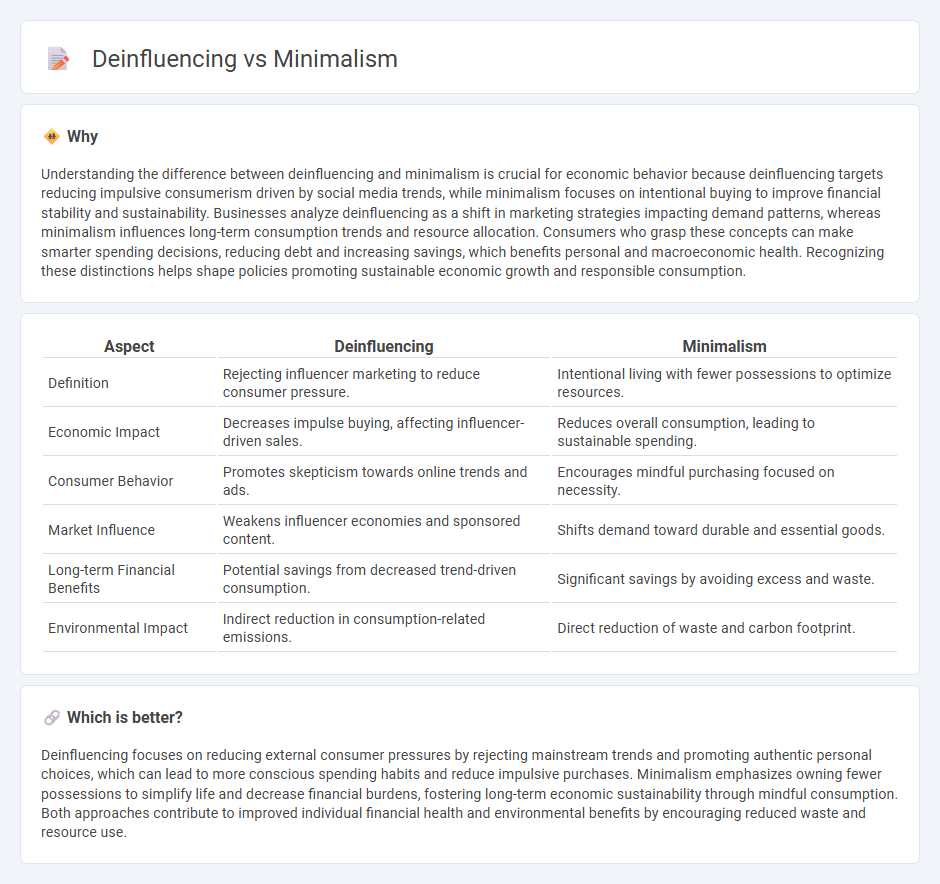
Deinfluencing challenges consumer culture by promoting conscious choices and rejecting influencer-driven trends, aligning closely with the economic principle of reducing demand for non-essential goods. Minimalism emphasizes living with fewer possessions to lower consumption and increase savings, impacting market dynamics by shifting spending habits. Discover how these movements reshape economic priorities and consumer behavior.
Why it is important
Understanding the difference between deinfluencing and minimalism is crucial for economic behavior because deinfluencing targets reducing impulsive consumerism driven by social media trends, while minimalism focuses on intentional buying to improve financial stability and sustainability. Businesses analyze deinfluencing as a shift in marketing strategies impacting demand patterns, whereas minimalism influences long-term consumption trends and resource allocation. Consumers who grasp these concepts can make smarter spending decisions, reducing debt and increasing savings, which benefits personal and macroeconomic health. Recognizing these distinctions helps shape policies promoting sustainable economic growth and responsible consumption.
Comparison Table
| Aspect | Deinfluencing | Minimalism |
|---|---|---|
| Definition | Rejecting influencer marketing to reduce consumer pressure. | Intentional living with fewer possessions to optimize resources. |
| Economic Impact | Decreases impulse buying, affecting influencer-driven sales. | Reduces overall consumption, leading to sustainable spending. |
| Consumer Behavior | Promotes skepticism towards online trends and ads. | Encourages mindful purchasing focused on necessity. |
| Market Influence | Weakens influencer economies and sponsored content. | Shifts demand toward durable and essential goods. |
| Long-term Financial Benefits | Potential savings from decreased trend-driven consumption. | Significant savings by avoiding excess and waste. |
| Environmental Impact | Indirect reduction in consumption-related emissions. | Direct reduction of waste and carbon footprint. |
Which is better?
Deinfluencing focuses on reducing external consumer pressures by rejecting mainstream trends and promoting authentic personal choices, which can lead to more conscious spending habits and reduce impulsive purchases. Minimalism emphasizes owning fewer possessions to simplify life and decrease financial burdens, fostering long-term economic sustainability through mindful consumption. Both approaches contribute to improved individual financial health and environmental benefits by encouraging reduced waste and resource use.
Connection
Deinfluencing and minimalism intersect in driving consumer behavior toward reducing excess purchases and prioritizing intentional spending, which supports sustainable economic practices. By promoting mindful consumption, both trends influence market demand, encouraging businesses to focus on quality over quantity and fostering resilience in supply chains. This shift can lead to more balanced economic growth by mitigating overproduction and reducing waste in global markets.
Key Terms
Consumerism
Minimalism emphasizes owning fewer, high-quality items to reduce clutter and promote intentional living, while deinfluencing encourages critical evaluation of marketing trends to resist excessive consumerism. Both approaches challenge the culture of overconsumption by prioritizing mindful purchasing decisions and sustainability. Explore how adopting minimalism or deinfluencing strategies can reshape your relationship with consumerism and enhance financial well-being.
Sustainability
Minimalism emphasizes reducing consumption by owning fewer, high-quality items to lessen environmental impact, while deinfluencing challenges consumer trends, encouraging conscious purchases to combat overconsumption and waste. Both approaches promote sustainability by fostering mindful choices that reduce carbon footprints and resource depletion. Explore these concepts further to enhance your sustainable lifestyle strategies.
Spending Habits
Minimalism emphasizes intentional spending by prioritizing quality over quantity, reducing unnecessary purchases, and fostering financial discipline to achieve a clutter-free lifestyle. Deinfluencing promotes critical evaluation of consumer trends and social media-driven desires, encouraging individuals to resist impulsive spending influenced by external pressures. Explore the differences between these approaches to develop mindful spending habits that align with your values.
Source and External Links
Minimalism - An art movement originating in the post-war era characterized by use of essential materials and simplicity, which has also evolved into a lifestyle focusing on using only essentials to reduce clutter, waste, and unnecessary acquisition for a more focused and simple life.
What Is Minimalism? - Minimalism is intentionally promoting what is most valuable by removing distractions, aiming for freedom from consumerism and modern life's frantic pace, and valuing relationships, experiences, and soul-care over possessions.
What Is Minimalism? - Minimalism is a tool to eliminate life's excess, enabling focus on important things to find happiness, fulfillment, and freedom, with each minimalist living differently but sharing the goal of pursuing purpose-driven lives.
 dowidth.com
dowidth.com